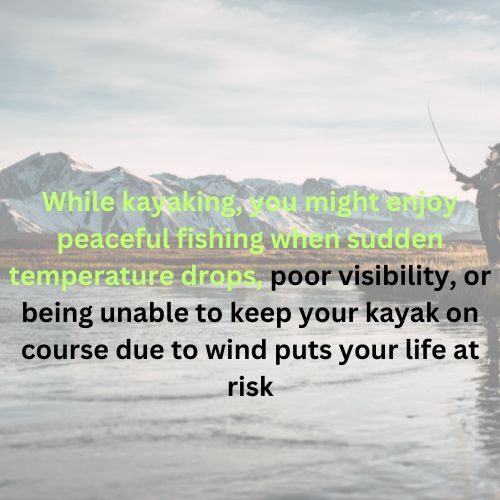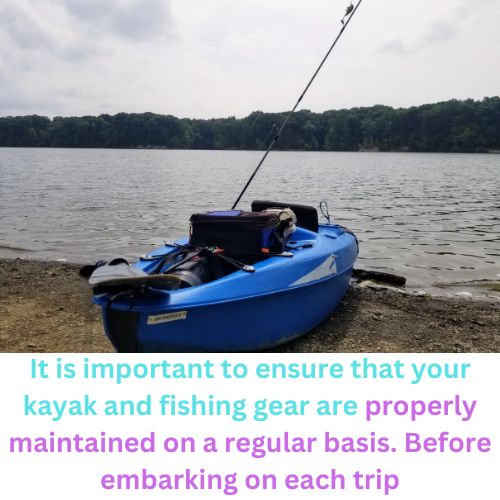There are multiple types of fishing one type of fishing is kayak fishing which is a recreational activity many anglers think is kayak fishing dangerous. It offers the anglers a new and immersive experience, allowing them to get up close and personal with their favorite fishing places. But the question arises is kayak fishing dangerous? However, kayak fishing also involves risks and challenges like other outdoor activities.
jump to a specific section
- 1 Kayak Fishing’s Allure
- 2 What are the Dangers of Kayak Fishing
- 3 5 Essential Safety Tips You Need to Know
- 4 1-Understanding the Risks of Kayak Fishing
- 5 Wearing a Personal Flotation Device (PFD)
- 6 Checking Weather Conditions
- 7 Equipping Your Kayak Properly
- 8 Navigation Hazards
- 9 Precautions and Is Kayak Fishing Dangerous
- 10 Final Conclusion
- 11 Resources
Kayak Fishing’s Allure
Before knowing is kayak fishing dangerous we will delve into why people do kayak fishing offers numerous advantages, such as:
- Kayaks are lightweight and easy to handle which will help to move shallow water and small places where large boats can not access easily.
- The cost of kayaks is relatively low compared to the price of powerboats, which makes the sport accessible to a wide range of people.
- Kayaks have less environmental impact because it does not need any type of fuel they promote eco-friendly fishing practice.
- Kayak fishing is the best way to promote physical fitness and it connects us with nature.
- Kayak fishing being close to water and nature adds the elements of adventure to us.
However kayaks fishing has many advantages but is kayak fishing dangerous
What are the Dangers of Kayak Fishing
We get our answer is kayak fishing dangerous it has some risks and it is dangerous in some ways. There are some key points of that.
Capsizing and Drowsing
Capsizing and drowsing are two different types of danger that occur while in or around the water. It will happen to anyone expert or a beginner you can not avoid this if you practice this whenever you go kayak fishing you must wear a personal flotation device. Capsizing happens when a boat flips over in the fishing water which can result in those aboard falling into the water while drowsing happens when an angler cannot keep their head above water and can not breathe resulting in suffocation.

It is essential to follow precautions to prevent capsizing and drowing You must wear safety jackets and be aware of water and weather conditions.
Being Lost
When you kayak fishing in open water it is easy to get lost because of fewer landmarks. It is possible that you are disoriented or unable to realize how far you paddled. However, a small distraction and seeing beautiful scenery can result in you losing your path.
Moreover, also tell someone about your float plan in case you do not come in time they find them by using a kayak fishing GPS. Landmarks like mountains and hills are the best marks for you to not forget your path and guide you to back your location. Before going kayak fishing you must be ready for how will you handle it if you lost in the ocean it will help you to stay relaxed and avoid panicking if you lose your way.

Errors in Equipment
We will know whether Is kayak fishing dangerous or not big mistake that occurs in kayak fishing is errors in the types of equipment kayak fishing leaks, paddle, and fishing gear break. It can be very distressing to have to deal with broken equipment while fishing. For instance, just imagine if your kayak suddenly fails or your paddle breaks while you’re in the middle of the sea. This kind of situation can be hazardous and could require you to call for help if there is too much leakage.
Creatures that can be Dangerous
It is possible to face wildlife when you go kayak fishing which puts your life in danger. In the ocean, you catch a fish or come across such as sharks, crocodiles, poisonous snakes, and bugs are the dangerous creatures that you might encounter to save your life. Insect repellent works against bugs, but there are no repellents for animals. Become aware of them and learn how to avoid them.
Big Boats
When you fish at night it is dangerous for you because at night you can be unable to see small crafts like kayaks which is the reason is kayak fishing dangerous. If your kayak collides you will get a lot of damage.

However, to save yourself maximize your visibility equip reflective jackets, and attach good lights and a big flag to your boat to protect it from colliding at night always on 360 white light to see things clearly. Moreover from collision big boats move fast and create big waves which can result in sinking your kayak easily. Be vigilant when boating. Give larger crafts the right of way and lean into sideways waves to avoid capsizing.
Water and Weather Conditions
It is an essential step to check the weather conditions before going kayak fishing many anglers ignore that but it causes serious injury. A situation occurs when high wind, heavy rain, lighting, and thunder kayaks do not provide too much safety. While kayaking, you might enjoy peaceful fishing when sudden temperature drops, poor visibility, or being unable to keep your kayak on course due to wind puts your life at risk.

However, during the cold season sudden immersion in the cold water can result in water shocks and later hypothermia. When kayaking, wear appropriate clothing such as a dry or wet suit, a well-fitting personal flotation device, and carry extra clothing. It is also safer to kayak in a group.
Reducing The Danger
The key to safe kayak fishing is education and training. Through courses and hands-on experience, learn kayaking and fishing techniques. These courses will help you to learn how to handle the worst situations like if the paddle is broken, the kayak leaks, different water conditions, and emergencies. These are invaluable skills for staying safe on the water.
It is very important to use safety gear during kayak fishing it is most important to wear a personal flotation device and ensure that your personal flotation device is according to your body size and it correct type of jacket for kayak fishing.
Moreover always carry other safety equipment that will help in emergencies like safety whistles, flare guns, and first aid kits in case of need. We get the answer is kayak fishing dangerous and how to save from these dangers.
It is important to ensure that your kayak and fishing gear are properly maintained on a regular basis. Before embarking on each trip, inspect your equipment to make sure it is in good working order. Accidents can happen while kayaking due to broken paddles, fishing rods, or leaks.

By addressing these issues beforehand, you can prevent these mishaps and have a safe experience on the water. By taking these safety precautions, you can significantly reduce the risks associated with kayak fishing.
5 Essential Safety Tips You Need to Know
1-Understanding the Risks of Kayak Fishing
Capsizing
Kayak fishing can often lead to capsizing, especially if you’re reaching for a catch or making sudden movements. Rough waters or strong currents further increase this risk.
Drowning
Falling out of your kayak or capsizing can result in drowning, particularly if you’re not wearing a personal flotation device (PFD). Even strong swimmers can struggle in open water.
Exposure to the Elements
Fishing exposes you to weather extremes, such as intense sun, rain, or wind. Prolonged exposure can lead to hypothermia or sunburn if not managed properly.
Wildlife Encounters
Natural water bodies might have aggressive wildlife or insects, posing safety risks. Encounters with these creatures can be dangerous if precautions aren’t taken.
Navigation Hazards
Submerged rocks, logs, or shallow areas can damage your kayak or cause accidents. Navigating these obstacles carefully is essential to avoid mishaps.
Limited Communication
Being on a small kayak can limit your ability to communicate or seek help in emergencies. This isolation increases the risk if something goes wrong and you need assistance.
Wearing a Personal Flotation Device (PFD)
Importance of a PFD
Wearing a Personal Flotation Device (PFD) is crucial for kayak fishing safety. A PFD keeps you afloat if you capsize or fall into the water, significantly reducing the risk of drowning. Even experienced swimmers can struggle in open water or under stressful conditions, making a PFD a vital piece of safety equipment.
Prevents Accidents
A well-fitting PFD provides buoyancy and support, helping you stay on the surface and maintain stability. This is especially important in rough waters or if you’re fishing from a kayak that may become unstable. A PFD also helps you stay calm and conserve energy while awaiting rescue if needed.
Types of PFDs
There are various types of PFDs designed for different water activities. For kayak fishing, choose a PFD that offers comfort, freedom of movement, and storage for fishing gear. Ensure it’s properly fitted and adjustable to prevent it from slipping off during an emergency.
Legal Requirements
In many regions, wearing a PFD while kayaking is not just a safety recommendation but a legal requirement. Familiarize yourself with local regulations to ensure compliance and enhance your safety on the water.
Checking Weather Conditions
Importance of Monitoring Weather
Before heading out for a kayak fishing trip, it’s essential to check the weather forecast. Adverse weather conditions can significantly impact safety, making it crucial to be aware of what to expect. High winds, storms, or sudden temperature changes can create dangerous conditions that may compromise your safety on the water.
Effects of Adverse Weather
- High Winds: Strong winds can make it difficult to control your kayak, increase the risk of capsizing, and create hazardous waves. This can affect your ability to navigate and make returning to shore challenging.
- Storms: Thunderstorms and heavy rain can lead to rapid changes in water conditions, including increased currents and reduced visibility. Lightning also poses a risk, as open water offers little protection.
- Temperature Changes: Sudden drops in temperature can lead to hypothermia, especially if you fall into cold water. Similarly, extreme heat can cause dehydration and heatstroke.
Preparation and Precautions
Always check for weather updates before setting out and be prepared to alter your plans if conditions worsen. Carry weather-appropriate gear, such as waterproof clothing and sun protection, and ensure you have a plan for returning to shore safely if weather conditions deteriorate.
Equipping Your Kayak Properly
Personal Flotation Device (PFD)
A PFD is crucial for safety. It keeps you afloat if you capsize or fall into the water, reducing the risk of drowning. Ensure it fits well and is comfortable for extended wear.
Whistle
A whistle is essential for signaling distress or attracting attention. It’s a simple yet effective tool for emergencies, helping others locate you if needed.
Signaling Mirror
A signaling mirror reflects sunlight and helps you communicate over long distances. It’s useful for signaling for help or attracting attention in emergencies.
First Aid Kit
Carry a basic first aid kit with bandages, antiseptic, and personal medications. It allows you to address minor injuries and health issues promptly while on the water.
Safety Knife
A safety knife is important for cutting through entangled gear or ropes. It’s a vital tool in emergencies where quick action is required.
Throw Bag
A throw bag with a rope can assist in rescuing others or retrieving items from the water. It’s an important safety device for any kayaking trip.
Dry Bags
Use dry bags to keep your gear and essentials dry. They protect your belongings from water and help keep your kayak organized.
Kayak Bilge Pump
A bilge pump helps remove water that accumulates in your kayak, maintaining stability and dryness.
Emergency Flare
In some regions, carrying an emergency flare is a legal requirement. It’s used to signal for help in critical situations.
Fishing Gear
Secure your fishing gear with rod holders and tackle boxes. This keeps your equipment organized and prevents it from causing hazards or falling overboard.
Submerged Rocks
Submerged rocks are a common hazard in kayak fishing. They can damage your kayak’s hull or cause you to lose control. Always stay alert to changes in water depth and look out for rocky areas, especially in shallow waters.
Logs and Debris
Fallen logs and floating debris can obstruct your path and pose risks to your safety. They can be difficult to see, especially in murky water, and may cause your kayak to tip or become stuck. Carefully navigate around these obstacles and avoid paddling too close.
Shallow Areas
Shallow areas can be tricky, as they may not be visible from the surface. Entering shallow water can lead to grounding or damage to your kayak’s underside. Use a depth finder or consult local maps to identify and avoid shallow zones.
Avoiding Hazards
To navigate safely, familiarize yourself with the waterway before setting out. Use charts, maps, or GPS to help identify potential hazards. Keep a safe distance from known obstacles and always remain vigilant to sudden changes in your surroundings.
Isolation Risk
Being on a small kayak can significantly limit your ability to communicate with others or call for help. This isolation becomes particularly risky in emergencies where immediate assistance is needed.
Emergency Communication
Due to the limited size of a kayak, carrying communication devices like a marine radio or a fully charged cell phone in a waterproof case is essential. These devices can be crucial for reaching out to rescue services or alerting fellow boaters if you’re in distress.
Backup Plans
Have a plan for emergencies, such as knowing the location of the nearest help stations or identifying the safest routes back to shore. Ensure that someone on land is aware of your planned route and expected return time so they can alert authorities if needed.
Stay Visible
Increase your visibility on the water by using bright-colored gear, flags, or lights. This helps others spot you more easily, especially in low-light conditions or adverse weather, improving your chances of receiving timely assistance if necessary.
Precautions and Is Kayak Fishing Dangerous
We all know that is kayak fishing dangerous but there are some precautions to save from it.
- Always wear a personal flotation device when you go kayak fishing. In many places, it is a legal step if this step is not followed by anglers then will pay heavy fines.
- Always pick a stable kayak for fishing because it is dangerous for your life.
- Check weather conditions before going kayak fishing because a situation occurs when we do not check the conditions and high wind and rain will happen which is dangerous for you.
- If you are going fishing inform someone if in case you are not coming they will search for you.
- In the summer season to save from the sun it is recommended that equip sunglasses, sunblock, and a hat to save sun rays because sometimes sun rays are very dangerous for you
- If you kayak fishing consistently it will help you to maintain stability and you will learn how to handle different water conditions
- While you doing kayak fishing it is important to ensure that not harm any sea animals and do not disrupt their environment Additionally, proper disposal of trash is necessary to keep the environment clean.
Final Conclusion
Kayak fishing is a recreational and rewarding activity and it has some benefits as well as some risks question arises is kayak fishing dangerous. We will reduce these dangers by following all precautions and safety measures. Kayak fishing is the best way that connect us with nature spending time in the water relaxes our minds and we will forget the all concerns of our lives.
Kayak fishing has less environmental impact because it does not use any type of fuel and does not release any gas. Kayak fishing is a proper workout because this is very time-consuming. In this activity, we spend our most of our time in the water to catch fish. Kayak fishing has many advantages it connects us with nature but it has some disadvantages. Is kayak fishing dangerous this question actually a question in mind before going kayak fishing the answer to this is kayak fishing dangerous in some situations but most of the time it is safe.
However, it is essential that you know about kayak fishing and always wear a personal floatation device and if you are going for kayak fishing first you must take advice from an expert about it.